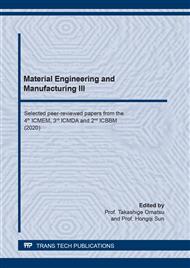[1]
K. R. Jha and G. Singh, Terahertz planar antenna for future wireless communication: A technical review, Infrared Physics & Technology, vol.60, pp.71-80, (2013).
DOI: 10.1016/j.infrared.2013.03.009
Google Scholar
[2]
F. H. L. Koppens D. E. Chang, and F. J G. Abajo, Graphene Plasmonics: A Platform for Strong Light-Matter Interactions,, Nano Lett. , vol.11 (8), pp.3370-3377, (2011).
DOI: 10.1021/nl201771h
Google Scholar
[3]
S. Dash, and A. Patnaik, Material selection for THz antennas,, Microwave and Optical Technology Letters, vol. 60, pp.1183-1187, (2018).
DOI: 10.1002/mop.31127
Google Scholar
[4]
S. Dash, A. Patnaik and B. K. Kaushik, Performance Enhancement of Graphene Plasmonic Nanoantenna For THz Communication,, IET Microwaves, Antennas & Propagation, vol. 13, no. 1, pp.71-75, (2019).
DOI: 10.1049/iet-map.2018.5320
Google Scholar
[5]
S. Dash, and A. Patnaik, Sub-wavelength Graphene Planar nanoantenna for THz Application,, Materials Today: Proceedings, vol. 18, Part 3, pp.1336-1341, (2019).
DOI: 10.1016/j.matpr.2019.06.598
Google Scholar
[6]
A. Akhavan, S. Abdolhosseini, H. Ghafoorifard, and H. Habibiyan, Narrow Band Total Absorber a Near-Infrared Wavelengths Using Monolayer Graphene and Sub-Wavelength Grating Based on Critical Coupling, IEEE Journal of Lightwave Technology, vol. 36 (23), (2018).
DOI: 10.1109/jlt.2018.2876374
Google Scholar
[7]
D. Rodrigo O. Limaj, D. Janner, D. Etezadi, F. J. G. Abajo, V. Pruneri, and H. Altug, Mid-infrared plasmonic biosensing with graphene,, Science, vol. 349, no. 6244, p.165–168, (2015).
DOI: 10.1126/science.aab2051
Google Scholar
[8]
M. Liu, X. Yin, E. Ulin-Avila, B. Geng, T. Zentgraf, L. Ju, F. Wang and X. Zhang, A graphene-based broadband optical modulator,, Nature, vol. 474, no. 7349, p.64–67, (2011).
DOI: 10.1038/nature10067
Google Scholar
[9]
C.-H. Liu, Y. Chang, T. B. Norris, and Z. Zhong, Graphene photodetectors with ultra-broadband and high responsivity at room temperature,, Nature Nanotechnol., vol. 9 (4), p.273–278, (2014).
DOI: 10.1038/nnano.2014.31
Google Scholar
[10]
C. Liaskos, S. Nie, A. Tsioliaridou, A. Pitsillides, S. Ioannidis, and I. Akyildiz, A novel communication paradigm for high capacity and security via programmable indoor wireless environments in next-generation wireless systems,, Ad Hoc Networks, vol. 87, pp.1-16, (2019).
DOI: 10.1016/j.adhoc.2018.11.001
Google Scholar
[11]
L. Ju, B. Geng, J. Horng, C. Girit, M. Martin, Z. Hao, H. A. Bechtel, X. Liang, A. Zettl, Y. R. Shen, and F. Wang, Graphene plasmonics for tunable terahertz metamaterials,, Nat. Nanotech., vol. 6, pp.630-634, (2011).
DOI: 10.1038/nnano.2011.146
Google Scholar
[12]
A. K. Geim, and K. S. Novoselov, The rise of graphene,, Nature Materials, vol. 6, p.183–191, (2007).
Google Scholar
[13]
V. Gusynin, S. Sharapov, J. Carbotte, Magneto-optical conductivity in graphene,, J. Phys.: Cond. Matter, vol. 19, no. 2, pp.026-222(1–28), (2006).
DOI: 10.1088/0953-8984/19/2/026222
Google Scholar
[14]
W. Fuscaldo, P. Burghignoli, P. Baccarelli, and A. Galli et al., Complex Mode Spectra of Graphene-Based Planar Structures for THz Applications,, J Infrared Milli Terahertz Waves, vol. 36, p.720–733, (2015).
DOI: 10.1007/s10762-015-0178-0
Google Scholar
[15]
A. Vakil and N. Engheta, Transformation optics using graphene,, Science, vol. 332(6035), p.1291–1294, (2011).
DOI: 10.1126/science.1202691
Google Scholar


